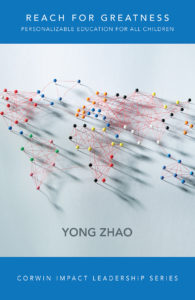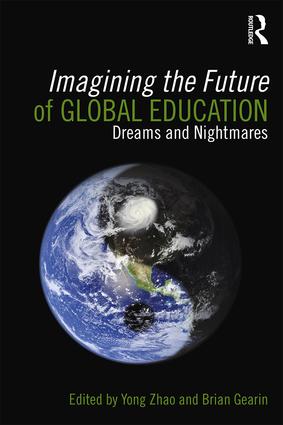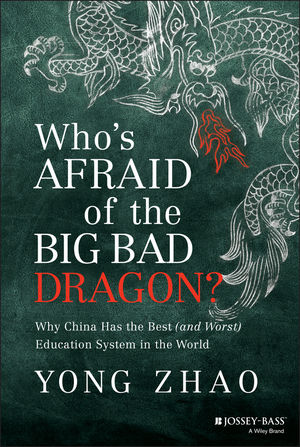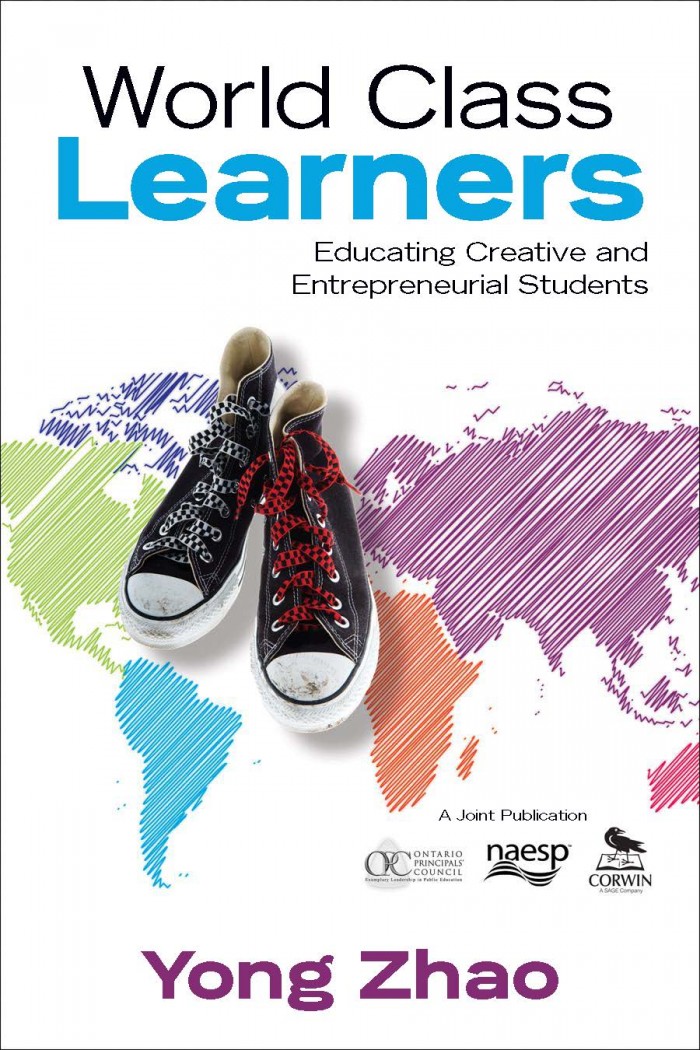Stop Looking at My Bad Leg: Introduction to my new book: Reach for Greatness
 My latest book Reach for Greatness: Personalizable Education for All has ben released by Corwin Press. You can order it from Corwin or Amazon. Below is the Introduction.
My latest book Reach for Greatness: Personalizable Education for All has ben released by Corwin Press. You can order it from Corwin or Amazon. Below is the Introduction.
********************
Benjamin Franklin wrote about a philosopher friend of his who used his two legs to determine with whom to avoid acquaintances more than 200 years ago. In The Deformed and Handsome Leg, Franklin says there are two kinds of people: One always finds beauty and good in things and people and thus is happy and pleasant to be with, while the other always looks for the contrary and thus is unhappy and unpleasant all the time. Franklin advises that we should stay away from the latter at all costs. To determine the kind of people in a stranger, Franklin’s friend noted the stranger’s reaction to his legs. Franklin’s friend had one “remarkably handsome” leg and “the other by some accident crooked and deformed. If a Stranger at the first Interview, regarded his ugly Leg more than his handsome one, he doubted him. If he spoke of it, and took no Notice of the handsome Leg, that was sufficient to determine my Philosopher to have no farther Acquaintance with him” (Franklin, 1998).
Unfortunately, most children do not have the same luxury as Franklin’s philosopher friend to decide whether they want to continue the acquaintance with such an unpleasant character. Education today is very much like the stranger who keeps looking at Franklin’s friend’s ugly leg more than his handsome one. It is obsessed with what children do not know or are unable to do. Worse, education today has developed various ways to speak about children’s deficiency, publicly and loudly, in the forms of tracking, grade retention, and sorting into different programs such as special education, summer remediation, and extra tutoring. It goes even beyond talking about children’s presumed deficiencies; education today works very hard to fix them, ignoring and potentially harming the handsome leg.
What made education such an unpleasant character is the gap mindset. The primary mission of education, as believed by many, is to instill in all children a set of knowledge and skills at a similar pace. This set of knowledge and skills, usually codified as curriculum standards, is presumed to be necessary for successful living in a society. To ensure all children are equipped with the prescribed skills and knowledge at the same pace, education has developed an elaborate system of assessments and checkpoints. Children are regularly (and frequently) assessed against the standards so as to detect and hopefully remedy any gaps.
Of course, gaps exist. Students’ mastery of the knowledge and skills, measured by standardized tests, varies a great deal. Some students seem to excel, while others lag behind. But for a variety of reasons, it has been found that groups of students with certain backgrounds as a whole seem to lag behind other groups. For example, in the United States, students from low-income families are less likely than their wealthier peers to demonstrate that they have achieved the prescribed standards. Similarly, ethnic minority students, particularly African American and Hispanic students, score lower than their Caucasian counterparts on standardized tests.
The gaps have received much attention around the world. Dubbed achievement gaps, many societies have enacted major policies and invested massive resources to close them. The United States is a prime example.
The Achievement Gap Mania in America
For nearly two decades, since the enactment of the No Child Left Behind Act of 2001 (NCLB) (“No Child Left Behind Act of 2001,” 2002) in 2002, America has been suffering from “achievement gap mania” (Hess, 2011). Closing the achievement gap has been the commanding, almost exclusive, goal of education in America. All educational efforts, be they in policy, research, or practice, must be justified on the grounds that they can help close the achievement gap. As a result, the nation has devoted all its educational resources to the campaign to narrow the chasm in test scores and graduation rates between students of different backgrounds, particularly in income and race.
The campaign has been a futile one. The gap between the poor and the rich has not narrowed significantly, nor has the chasm between children of color and their White counterparts (The Annie E. Casey Foundation, 2013; Curran & Kellogg, 2016; Plucker, Hardesty, & Burroughs, 2013)—in fact, it has widened (Ostashevsky, 2016; Reardon, 2011). The drastic policies put forth by NCLB, the billions of dollars, the numerous instructional innovations, and the tireless efforts of educators did not seem to have turned schools into an effective mechanism to alter the trajectory preset by children’s family background before they arrive at school. Today, factors associated with a child’s home remain much more powerful predictors of their future than do schools (The Annie E. Casey Foundation, 2010; Bailey & Dynaski, 2011; Curran & Kellogg, 2016; Duncan & Murnane, 2011; Fryer & Levitt, 2004; Reardon, 2011).
Worse, the campaign has been counterproductive (Hess, 2011). Beyond the squandered resources and opportunities, “achievement gap mania” has significantly changed American education for the worse. It
has led to education policy that has shortchanged many children. It has narrowed the scope of schooling. It has hollowed out public support for school reform. It has stifled educational innovation. It has distorted the way we approach educational choice, accountability, and reform (Hess, 2011).
It has also turned American education into test preparation, resulting in massive “collateral damages” (Nichols & Berliner, 2007). It has demoralized educators and students (Nichols & Berliner, 2008; Smith & Kovacs, 2011; Wong, Wing, & Martin, 2016), and it has deprived many children, particularly those whom the campaign was supposed to help, of the opportunities for a real education (Carter & Welner, 2013; Tienken & Zhao, 2013). Furthermore, it has reinforced the deficit mindset for minority students and concealed the real cause for educational inequality (Cross, 2007; Jones, 2013; Ladson-Billings, 2007).
Nevertheless, the campaign continues. The well-evidenced failure and damaging consequences of efforts summoned by NCLB to narrow the achievement gaps have apparently not caused American policymakers to change course. Although NCLB was replaced by the Every Student Succeeds Act (ESSA) in 2015 (“Every Student Succeeds Act,” 2015), closing the achievement gaps remains the commanding goal of education. Despite the mechanical changes, the purpose of the new education law “is to provide all children significant opportunity to receive a fair, equitable, and high-quality education, and to close educational achievement gaps” (“Every Student Succeeds Act,” 2015, Section 1001). Barring any significant changes, achievement gap mania will continue to reign over American education for the foreseeable future.
Rudolph and Me
Rudolph had a red nose. It is a deficit because the standard nose color is supposed to be black in reindeer country. So all efforts were applied to fix his nose color. And of course, the poor red-nosed reindeer was not normal and did not meet the standard. The other reindeers with black noses were the good ones and did not want to mix with the bad kid. But all the children around the world should be grateful that no one fixed Rudolph’s red nose because his red nose was the very thing Santa Claus needed for his sleigh on a foggy Christmas Eve.
I am grateful that no one tried to fix my deficits either. I am able to write this book not because I had planned to be a professor in the United States, but because I was not forced to fix my lack of ability and interest in becoming a farmer in China. I was born in a Chinese village and thus destined to become a farmer like everyone else in the village. But from a very early age, I discovered that I was not cut out to be a successful farmer. I was physically smaller and weaker than other boys. I could not drive water buffalos or climb trees or manipulate the hoe nearly as well as other boys. I tried to learn, and my father was a good teacher, but I was unable to master the farming skills. By any standard, I was way below the average of all the boys in terms of farming knowledge and abilities. There was a clear achievement gap in farming capabilities between me and the other boys in the village.
Luckily, my father did not try too hard to close my achievement gap. He gave up on me early. Instead of pushing me to become a better farmer, he sent me to school. In school, I discovered what I could be good at. My ability to handle reading was much better than my ability to deal with a water buffalo. After all, I could be good at something. And I liked that feeling. However, no one, including my father and myself, knew how I could make a living without farming at the time, when China was in the midst of a disastrous political campaign called the Great Cultural Revolution. The campaign dismantled the formal education system and sent the educated elite to remote rural areas to be “reeducated” by farmers. Education was thus not a way to get out of the village for a better life, like it is today. In other words, it was not the remote chance that education would bring a better life that motivated me to go to school. Instead, it was the feeling that I could be good at something, and the desire to avoid doing something I was not good at, that sustained my motivation to walk barefoot to school every day, in burning summers and freezing winters.
I am a big fan of the “growth mindset” (Dweck, 2008). I strongly believe that anyone can learn anything. But I have tried not to apply the idea to everything in life. I have avoided applying a growth mindset in football, for example, although I know if I indeed put 10,000 hours into it, as Malcolm Gladwell (2008) suggests in his book Outliers: The Story of Success, I could become better. But I also know very well that even if I put 100,000 hours into it, I will not be playing for the NFL because my 5’6” height and 150 lb. weight are way below the average height and weight of NFL players. No matter how hard I try, I probably won’t get there.
I have also avoided applying it in other undertakings. I gave up on putting 10,000 hours into painting quickly after I discovered that I could barely draw a straight line and the Chinese characters I produced always looked like the footprints of a chicken. I gave up studying math in high school because I did not enjoy math and I was not good at it. I received 3 points out of 120 in the College Entrance Exam in 1982.
I was able to go to college without studying math because of a policy that forgave my poor math performance. In the late 1970s and early 1980s, when Chinese education was recovering from the damages of the Cultural Revolution, it allowed students to major in foreign languages without being good at math. Math was not counted toward the total score of the College Entrance Exam for those applying to study foreign languages. To run away from my poor math, I chose to major in English in college. I was lucky because the policy ended in 1982. Math has since become a required core subject in the College Entrance Exam, which means Chinese students can no longer run away from math if they want to go to college.
I have been fortunate to be able to avoid virtually everything that I have no potential for being good at or I am not interested in. More important, I have been fortunate to have had the space to explore my passions and experiment with different undertakings to discover my weaknesses and strengths. Most people are not born knowing what they are interested in and can be good at. They can only find out through experiences.
But experiences have costs and risks. Every experience requires time, and some require money and extra effort. Thus, adults want every activity their children experience to be positive, to lead to some desirable outcome. They don’t want their children to waste their time, energy, or money, or worse, to have experiences that may have a negative impact. Responsible adults naturally have a tendency to prescribe experiences for children. The result is that many children are allowed to have only experiences deemed to be beneficial and safe by adults.
I was fortunate to have broader and more diverse experiences than most children. Although my experiences were severely constrained by the lack of resources and remoteness of my village, I enjoyed more freedom. As soon as I started school, my illiterate parents did not feel they could guide me anymore and thus allowed me to pursue whatever I thought appropriate throughout my life. My teachers in the village school were not well trained to make me follow a prescribed reading curriculum, so I was able to read anything I could find instead of a series of carefully selected graded reading materials. The assortment of used books, magazines, and newspapers my father collected for wrapping noodles in the village noodle factory not only taught me to read but also, more importantly, exposed me to a broad range of topics, way beyond what a very carefully designed curriculum can offer.
Neither my parents nor my teachers attempted to force me to do things they wanted or forbid me from doing things they did not like. I was free of external judgment and never feared it. So I got to have many different experiences, some more beneficial than others, but all were necessary for me to find my passion and strengths. In college, instead of devoting my energy to studying the English textbooks in the classroom, I spent more time reading English books and magazines on psychology, linguistics, and education. Rather than spending time memorizing English literature as required, I took on computer programming. Instead of worrying about my grades, I spent a tremendous amount of time programming a piece of statistics software for a research project. In the end, I developed great proficiency in English by not following the prescribed program.
I have learned to be very open to new experiences. I have always been willing to explore new opportunities. When opportunities present themselves, I jump right in as long as they look interesting, but I am not one who would keep at it at any cost when I realize that it is not something I can be great at or enjoy doing. For example, I tried making fish tanks after college but gave it up when I discovered I have no talent in engineering. I quit being a college teacher to join a translation business, but gave it up despite its success because I did not find it interesting. I returned to be a college teacher afterwards because I found that that was ultimately what interested me.
I was lucky on two fronts. First, I was lucky that my parents and schools did not force me to fix my weaknesses according to whatever their definitions of strengths or weaknesses were. They were very forgiving of my weaknesses and appreciative of my various adventures. Second, I was lucky that the massive societal transformations in China and the world over the past few decades made it possible for me to use my strengths and interests, just as the fog on Christmas Eve made it possible for Rudolph to change his fate. If China had not restored its education system after the Cultural Revolution, it would not have been possible for me to go to college. If China had not opened to the outside world, it would not have been possible for me to migrate to the United States. If I had not come to the United States, my passions and strengths would not have found as much value.
Fortunately, the changes I experienced in China are now widespread for everyone. In other words, the foggy Christmas has arrived for all due to technological changes. But unfortunately, the accidental great educational experiences I had are not widespread. To enable every child to be able to explore, experiment with, and enhance his or her strengths, education must change.
The Foggy Christmas Eve Has Arrived
The fundamental reason for people to worry about achievement gaps stems from two assumptions underlying education today. First, there is a set of skills and knowledge everyone must have in order to live a successful life in the world. Second, all children are capable of and interested in acquiring the skills and knowledge at a similar pace. Thus, if a child is found be behind others, we must act to help him or her catch up at any cost.
These assumptions are not true any longer. First, changes in society always redefine the value of knowledge and skills. What used to be useful can become useless and what used to be useless can become useful, as the experience of Rudolph and me suggests. Given recent changes brought about by technology, there has been growing recognition that traditionally valued skills and knowledge have become obsolete, and we need new human qualities for the new world (Florida, 2012; Partnership for 21st Century Skills, 2007; Pink, 2006; Trilling & Fadel, 2009; Zhao, 2016a).
Second, current understandings of human nature and human learning suggest that human beings are differently talented (Gardner, 1983, 2006) and have different desires and interests (Reiss, 2000, 2004). Thanks to the diversity in the environment in which they are born, humans also have different experiences that interact with their natural talents and interests to give each person a unique, jagged profile of abilities and desires, stronger in some areas and weaker in others (Ridley, 2003; Rose, 2016). In other words, everyone has a handsome leg and, at the same time, a deformed leg.
Third, in the new world where smart technology has replaced and will continue to replace humans in routine tasks, we need human beings to be unique, creative, and entrepreneurial (Schwab, 2015; Wagner, 2008, 2012; World Economic Forum, 2016). Thus, to succeed in the world, we need an education that helps everyone to become uniquely creative and entrepreneurial. Education needs to stop preparing students to become a homogenous group of average individuals—mediocre at everything but great at nothing—and to begin helping everyone to become great.
Greatness comes from lots of efforts (Coyle, 2009), but it can only be built on passion and strengths. If a person has no interest in a domain, it is unlikely that he or she would be intrinsically motivated to put in the necessary efforts needed for greatness. If a person spends the same effort on developing abilities in domains where he or she has neither talent nor rich resources, he or she is unlikely to become great either. Thus, an education that aims to cultivate greatness needs to be one that supports passion and enhances strengths, instead of fixing deficits or closing gaps. It is time to stop looking at the bad leg!
Plan of the Book
This book is about teaching for greatness. Chapter 1 discusses why education has been led to ignore passion and strengths. Chapter 2 makes the argument, based on current understanding of human abilities, that every child can be great. It also brings in research from different disciplines to show where strengths and passions can be found. In Chapter 3, I discuss humans’ need to become great in order to achieve peace with themselves and arrive at authentic happiness. Chapter 4 argues that in order to teach for greatness, we need to make education personalizable. Differing from personalized learning fundamentally, Personalizable Education gives students control over their own learning. Features of Personalizable Education are also discussed. In the last chapter, Chapter 5, I discuss what is needed to realize Personalizable Education for all children.




























Feel free to comment:
The views expressed on this site are entirely my own. They do not represent my employer or any other organization/institution. All comments are subject to approval.